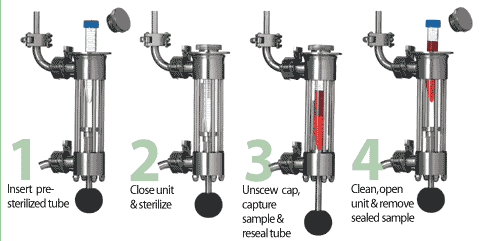|
|
SampleSafe™
Sample Collector
Economically capture and seal samples in sterile isolation |
The
Pharmenta® SampleSafe™ sample collector is a simple, compact device,
designed to fill and seal sample centrifuge tubes in a sterile chamber,
isolated from the work environment. The SampleSafe™ provides a
cost-effective way to minimize sample contamination risks while making
sampling safer for the operator, the process and the environment.
To operate the SampeSafe™ sample collector, insert a sealed,
presterilized sample tube into the SampleSafe chamber, sterilize in-line
with your sample valve, twist a knob to open the sample tube, open the
sample valve to fill, twist the knob to close the tube and then open the
SampleSafe™ extract a filled sealed sample tube.
To
see an animation of the SampleSafe™ sample collector in operation, click
one of the links at right.
|
Animation:
Click one of the links
below for an animation
of the SampleSafe™
collector in operation.
Read More:
Don't have the
Adobe Acrobat Reader?
Click
here.
|
| |
 |
|
The
SampleSafe™ sample collector works with most sampling valves, including
the Pharmenta AptiPort® sampling valve, and the Pharmenta SIPTube
multipurpose valve. It installs in-line in minutes onto existing process
equipment using standard connections.
Pharmenta SampleSafe™ sample collectors are available to work with 15 or
50 ml centrifuge tube sizes. They are suitable for pharmaceutical,
biotech, food and beverage and fine chemical applications.
|
|
|
